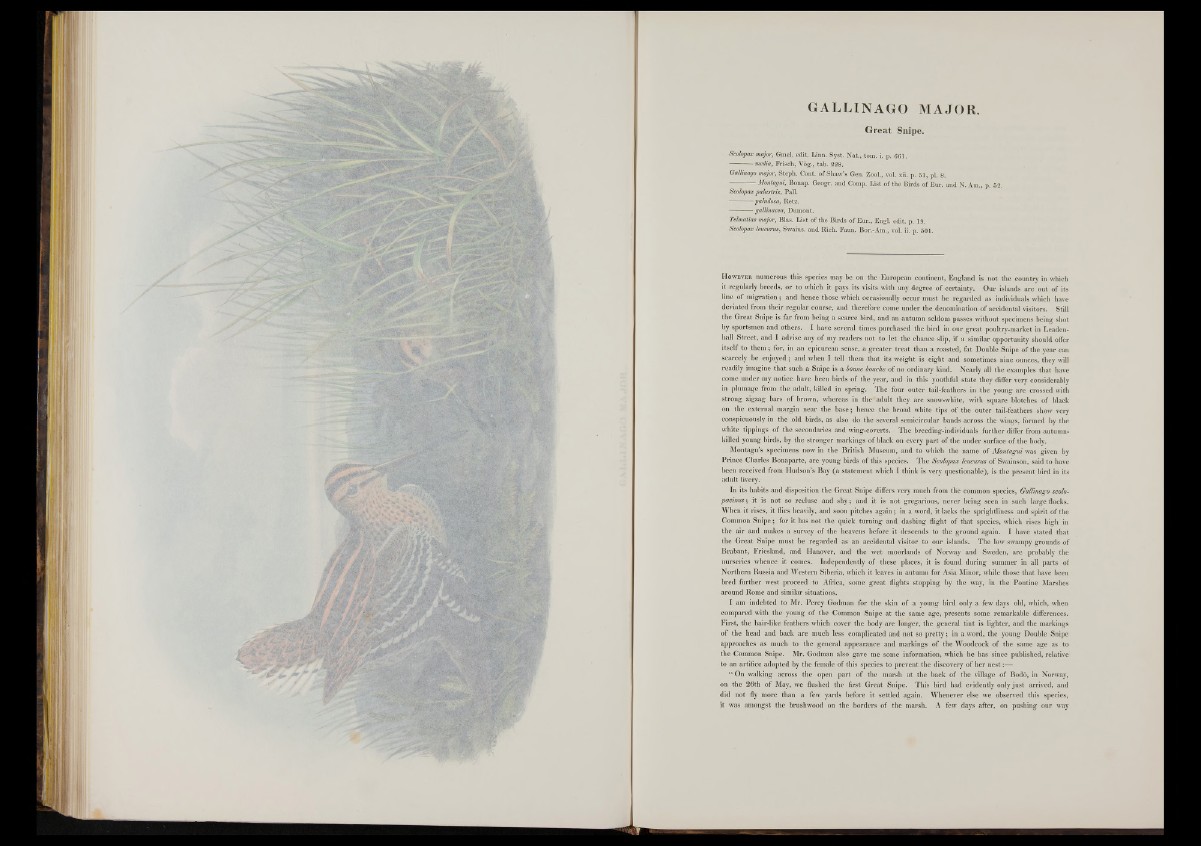
GALLINAGO MAJOR.
Great Snipe.
Scolopax major, Gmel. edit. Linn. Syst. Nat., tom. i. p. 661.
— - — media, Frisch, Vog., tab. 228.
Gallinago major, Steph. Cont. of Shaw’s Gen. Zool., vol. xii. p. 51, pi. 8.
------------Montagui, Bonap. Geogr. and Comp. List of the Birds of Eur. and N. Am., p. 52.
Scolopax palustri*, Palll&p ■
-----------paludosa, Retz.
gallinacea, Dumont.
Telmatias major, Bias. List of the Birds of Eur., Engl. edit. p. 19.
Scolopax leucurus, Swains, and Rich. Faun. Bor.-Am., vol. ii. p. 501.
H ow ev e r numerous this species maybe, on the-European continent, England is not the country in which
it regularly breeds, or to which it pays its visits with any degree of certainty. Our islands are out of its
line o f migration; and hence those which occasionally occur must be regarded as individuals which have
deviated from their regular course, and therefore come under the denomination of accidental visitors. Still
the Great Snipe is far from being a scarce bird, and an autumn seldom passes without specimens being shot
by sportsmen and others. I have several times purchased the bird in our great poultry-market in Leaden-
liall Street, and I advise any o f my readers not to let the chance slip, if a similar opportunity should offer
itself to them ; for, in an epicurean sense, a greater treat than a roasted, fat Double Snipe o f the year can
scarcely be enjoyed; and when I tell them that its weight is eight and sometimes nine ounces, they will
readily imagine that such a Snipe is a bonne bouche o f no ordinary kind. Nearly all the examples that have
come under my notice have been birds o f the year, and in this youthful state they differ very considerably
in plumage from the adult, killed in spring. The four outer tail-feathers in the young are crossed with
strong zigzag bars o f brown, whereas in the adult they are snow-white, with square blotches of black
on the external margin near the base; hence the broad white tips of the outer tail-feathers show very
conspicuously in the old birds, as also do the several semicircular bands across the wings, formed by the
white tippings o f the secondaries and wing-coverts. The breeding-individuals further differ from autumn-
killed young birds, by the stronger markings of black on every part of the under surface of the body.
Montagu’s specimens now in the British Museum, and to which the name of Montagui was given by
Prince Charles Bonaparte, are young birds of this species. The Scolopax leucurus o f Swainson, said to have
been received from Hudson’s Bay (a statement which I think is very questionable), is the present bird in its
adult livery.
In its habits and disposition the Great Snipe differs very much from the common species, Gallinago scolo-
pacinus; it is not so recluse and sh y ; and it is not gregarious, never being seen in such large flocks.
When it rises, it flies heavily, and soon pitches ag a in ; in a word, it lacks the sprightliness and spirit o f the
Common Snipe; for it has not the quick turning and dashing flight of that species, which rises high in
the air and makes a survey of the heavens before it descends to the ground again. I have stated that
the Great Snipe must be regarded as an accidental visitor to our islands. The low swampy grounds of
Brabant, Friesland, and Hanover, and the wet moorlands o f Norway and Sweden, are probably the
nurseries whence it comes. Independently o f these places, it is found during summer in all parts of
Northern Russia and Western Siberia, which it leaves in autumn for Asia Minor, while those that have been
bred further west proceed to Africa, some great flights stopping by the way, in the Pontine Marshes
around Rome and similar situations.
I am indebted to Mr. Percy Godman for the skin of a young bird only a few days old, which, when
compared with the young of the Common Snipe a t the same age, presents some remarkable differences.
First, the hair-like feathers which cover the body are longer, the general tint is lighter, and the markings
of the head and back are much less complicated and not so pretty ; in a.word, the young Double Snipe
approaches as much to the general appearance and markings of the Woodcock of the same age as to
the Common Snipe. Mr. Godman also gave me some information, which he has since published, relative
to an artifice adopted by the female o f this species to prevent the discovery o f h er n e s t:—
“ O n walking across the open part o f the marsh at the back of the village o f Bodo, in Norway,
on the 26th o f May, we flushed the first Great Snipe. This bird had evidently only ju st arrived, and
did not fly more than a few yards before it settled again. Whenever else we observed this species,
it was amongst the brushwood on the borders o f the marsh. A few days after, on pushing our way